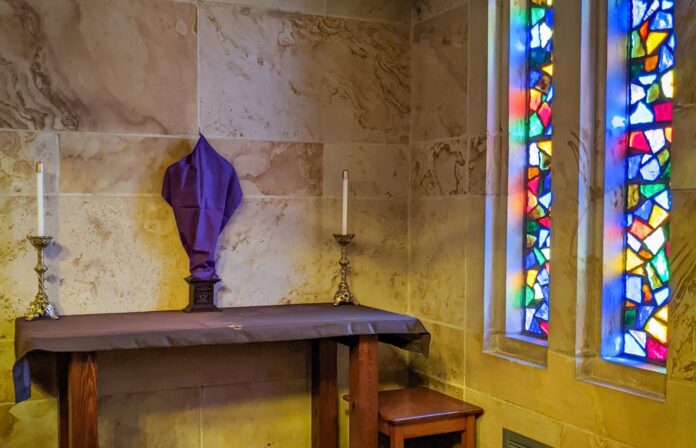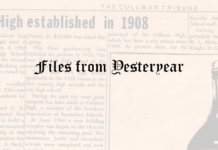CULLMAN, Ala. – The solemnity and seriousness of Holy Week are very evident in the Church of St. Bernard Abbey in Cullman. Crucifixes and images of saints are covered with violet cloth as Christians “fast” from the beauty and comfort of sacred images. Even the Abbey’s huge 10-foot Great Cross is shrouded, its bright colors invisible until Easter.
Christians around the world are celebrating Holy Week. It began on Palm Sunday and lasts through Easter Sunday. Holy Week is the center of the Christian Year, and the heart of Holy Week are the days of Holy Thursday through Easter Sunday, called the Sacred Triduum (Three Days). Especially during these days the Catholic monks of St. Bernard Abbey in Cullman welcome guests to their worship, ancient rites in praise of God who suffered for the world. The most popular services at the Benedictine Abbey will be:
- Thursday, April 6: Holy Thursday (Mass of the Lord’s Supper), 4 p.m.
- Friday, April 7: Good Friday (Liturgy of the Passion of Christ), 3 p.m.; (Tenebrae), 7:30 p.m.
- Saturday, April 8: The Great Easter Vigil of Saturday Night, 8 p.m.
- Sunday, April 9: Easter Sunday Mass, 10:30 a.m.
Said Abbot Marcus Voss, O.S.B., leader of the monastery of 33 Benedictine monks, “Holy Week began with Passion (Palm) Sunday, which commemorates Jesus’ entry into Jerusalem where, during the coming week, he would suffer, die and rise.”
The Abbot explained that Holy Week continues through to the Easter Triduum, the Great Three Days beginning Holy Thursday Evening and lasting through Easter Sunday Evening.
On Holy Thursday evening the institution of the Mass at the event called The Lord’s Supper is celebrated, and the abbot of the monastery washes the feet of twelve men in commemoration of Jesus’ washing of his disciples’ feet. Holy Thursday is sometimes called “Maundy Thursday” (from the Latin word “mandatum” or “command”), from Jesus’ command made on this day that his followers are to love as He loves – demonstrated in the very act of washing feet.
On Good Friday is remembered Jesus’ perfect act of love: His suffering and death. In that connection the cross is honored with great solemnity. On Friday evening is the service of Tenebrae (darkness), which sees the church gradually darken as Christ dies on the cross for the world and the earthquakes at the death of its Creator.
On Holy Saturday all keep watch with Jesus as He lies in the tomb until the darkness of Saturday evening. It is then that light pierces the darkness in the Easter Vigil. The Easter Vigil is the great celebration of Christ’s resurrection and victory over death. The service begins in the dark (8 p.m. on Saturday night) when the “New Fire” is lit outside the Abbey Church. From that fire the Paschal (Easter) Candle, which symbolizes Christ, is lit and taken into the church, where the candles of all worshippers receive the flame from the “Light of Christ” (Paschal Candle), destroying darkness and flooding the church with light.
Finally comes Easter Sunday morning and Easter Mass at 10:30 a.m.
“For almost 2,000 years Christians have worshipped God in special services during these holiest of days, and we are privileged to do the same,” said Abbot Marcus, “and we welcome all to join us.”
In the Church’s tradition, the veiling of crosses has several meanings: It is a “fasting” from sacred depictions which represent the Easter glory of salvation. Just as the Lenten fast concludes with the Easter feast, so too, fasting from the cross culminates in honoring the cross on which the sacrifice of Calvary was offered for the sins of the world on that first Good Friday. An important part of the Good Friday Liturgy is that honoring of the Cross, which includes its unveiling. Once the Cross has been unveiled, it is logical that all crosses would be unveiled so that they too might be honored by the faithful and remind all of the glory of the Holy Cross of Christ.
Likewise, a fasting from the wonderful images of the mysteries of faith and the saints in glory, ends at the Easter Vigil on Saturday night when all celebrate the victorious Christ, risen from the tomb.
Some writers explain that the veiling is to remind all of Jesus’ humiliation and to imprint the image of the crucified Christ more deeply on minds and hearts. The veiling of crosses and images, making them “present” but “absent,” draws attention to their importance and beauty – as wonderful objects that remind one of the gift of salvation and the communion of saints.























